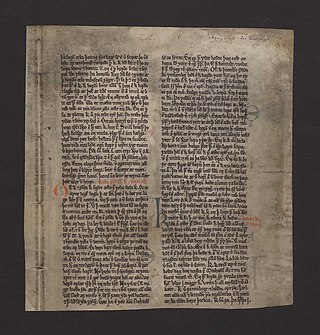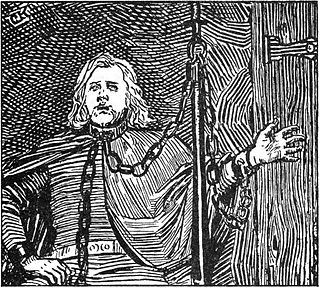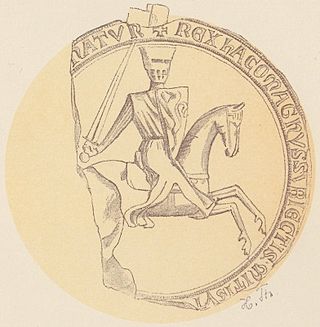
Heimskringla is the best known of the Old Norse kings' sagas. It was written in Old Norse in Iceland by the poet and historian Snorri Sturluson (1178/79–1241) c. 1230. The title Heimskringla was first used in the 17th century, derived from the first two words of one of the manuscripts.

A skald, or skáld is one of the often named poets who composed skaldic poetry, one of the two kinds of Old Norse poetry in alliterative verse, the other being Eddic poetry. Skaldic poems were traditionally composed to honor kings, but were sometimes extempore. They include both extended works and single verses (lausavísur). They are characteristically more ornate in form and diction than eddic poems, employing many kennings, which require some knowledge of Norse mythology, and heiti, which are formal nouns used in place of more prosaic synonyms. Dróttkvætt metre is a type of skaldic verse form that most often use internal rhyme and alliteration.
Knýtlinga saga is an Icelandic kings' saga written in the 1250s, which deals with the kings who ruled Denmark since the early 10th century.

Kings' sagas are Old Norse sagas which principally tell of the lives of semi-legendary and legendary Nordic kings, also known as saga kings. They were composed during the twelfth through the fourteenth centuries, primarily in Iceland, but with some written in Norway.
Hryggjarstykki is a lost kings' saga written in Old Norse in the mid-twelfth century and dealing with near-contemporary events. The author was Eiríkr Oddsson, an Icelander about whom little is known. The work is cited by Snorri Sturluson in Heimskringla, where its reliability is emphasized.

Hákonar saga Hákonarsonar or Hákonar saga gamla is an Old Norse Kings' Saga, telling the story of the life and reign of King Haakon Haakonarson of Norway.
Óláfs saga Tryggvasonar is the name of several kings' sagas on the life of Óláfr Tryggvason, a 10th-century Norwegian king.
Gunnlaugr Leifsson was an Icelandic scholar, author and poet. He was a Benedictine monk at the Þingeyraklaustur monastery in the north of Iceland. Many sources refer to him simply as Gunnlaugr munkr or Gunnlaugr the Monk.
Skúli Þórsteinsson was an 11th-century Icelandic poet and warrior. He was the grandson of Egill Skallagrímsson and a courtier of Jarl Eiríkr Hákonarson. A short account of his life is given at the end of Egils saga:
Hulda-Hrokkinskinna is one of the kings' sagas. Written after 1280, it relates the history of the Norwegian kings from Magnús góði, who acceded to the throne in 1035, to Magnús Erlingsson, who died in 1177.
Halldórr skvaldri was an Icelandic skald who lived in the first half of the twelfth century.
Íslendings þáttr sögufróða is a very short þáttr about a young Icelandic storyteller at king Haraldr Sigurðarson's court. This þáttr, which may have been written at the end of the 13th century, was preserved in the Morkinskinna, Hulda and Hrokkinskinna manuscripts.

Haralds saga Sigurðarsonar is an Old Icelandic king's saga focusing on the career of King Haraldr Sigurðarson of Norway.
Auðunar þáttr vestfirska is a short tale preserved in three distinct versions as part of the saga of Harald III of Norway, as the saga is told in the manuscripts Morkinskinna, Flateyjarbók, and several others. Widely translated and anthologised, it is admired for its beautifully simple account of a poor Icelander from the Westfjords, the harshest region of the country, who decides to take a polar bear as a present to Sweyn II of Denmark. Auðun sticks to his task despite having to pass through the court of Haraldr, who is continually at odds with Sweyn, and proceeds on a pilgrimage to Rome. Auðun's mixture of determination, audacity and humility leads him to gain the respect of both kings, and through him their respect for one another increases also.
Bjaðmunjo Mýrjartaksdóttir was a daughter of a Muirchertach Ua Briain, High King of Ireland. In 1102, whilst still a child, she was married to Sigurðr, son of Magnús Óláfsson, King of Norway. At this time, Magnús appears to have been in the process of setting up his son as king over the Earldom of Orkney, the Kingdom of the Isles, and the Kingdom of Dublin. The marriage temporarily bound Muirchertach and Magnús together as allies before the latter's death the following year. Sigurðr thereupon repudiated Bjaðmunjo, and left for Scandinavia, where he proceeded to share the Norwegian kingship with his brothers.
Bjaðǫk was a twelfth-century woman purported to have been the mother of Eysteinn Haraldsson, King of Norway. In the first half of the twelfth century, Eysteinn was brought to Norway and claimed to be the son of his royal predecessor, Haraldr gilli, King of Norway. The latter was himself the son of a Gaelic woman, and claimed to be the son of an earlier king. The claims of Bjaðǫk and Eysteinn were accepted, and the latter went on to rule as king for fifteen years. Bjaðǫk's name could to be an Old Norse form of a Gaelic name, and she may well have been a member of a prominent family. According to modern tradition, Haraldr gilli's wife was an aunt of Somairle mac Gilla Brigte, King of the Isles, although whether this tradition is authentic is uncertain.
Bergbúa þáttr is a short medieval Icelandic tale (þáttr). It tells of Þórðr and his companion who get lost on their way to church one winter and take refuge in a cave. Once inside, after they have settled down for the evening, they hear noises from the back of the cave. Later they see two huge eyes and hear a voice which recites a poem of twelve stanzas, now known as Hallmundarkviða. The speaker of these verses refers to himself as a giant, and repeats the poem three time across the course of the night. The giant instructs the humans to remember the poem or suffer a forfeit. Þórðr memorises the poem but his companion does not and subsequently dies the following year.
Kumlbúa þáttr is a short medieval Icelandic tale (þáttr) set at the end of the twelfth century or the beginning of the thirteenth. It tells the story of Þorsteinn Þorvarðsson who stumbles upon a burial cairn and takes a sword from it. After he returns home he goes to bed and is visited in a dream by the cairn-dweller. The man, who wields a huge pole-axe, demands the return of the sword and threatens Þorsteinn. Þorsteinn's wife wakes him to ask why he is sleeping so poorly but he does not tell her and goes back to sleep at once. The cairn-dweller reappears and declaims a threatening verse. However, Þorsteinn retorts with a more technically proficient verse which 'caps' that of the cairn-dweller who then leaves Þorsteinn. The following day Þorsteinn goes to look for the cairn but cannot find it. He returns home and tells his wife and other people the story.

Codex Frisianus or Fríssbók is a manuscript of the early fourteenth century. Among its 124 folios, it contains Heimskringla and Hákonar saga Hákonarsonar.

Valgarðr á Velli was an 11th-century skald in the service of King Harald Hardrada of Norway. Little is known about his life or origin but his name suggests he may have been a kinsman, perhaps a son, of Mörðr Valgarðsson of Völlr, a chieftain who plays a role in Njáls saga. He is listed in Skáldatal among the court poets of Harald Hardrada.







